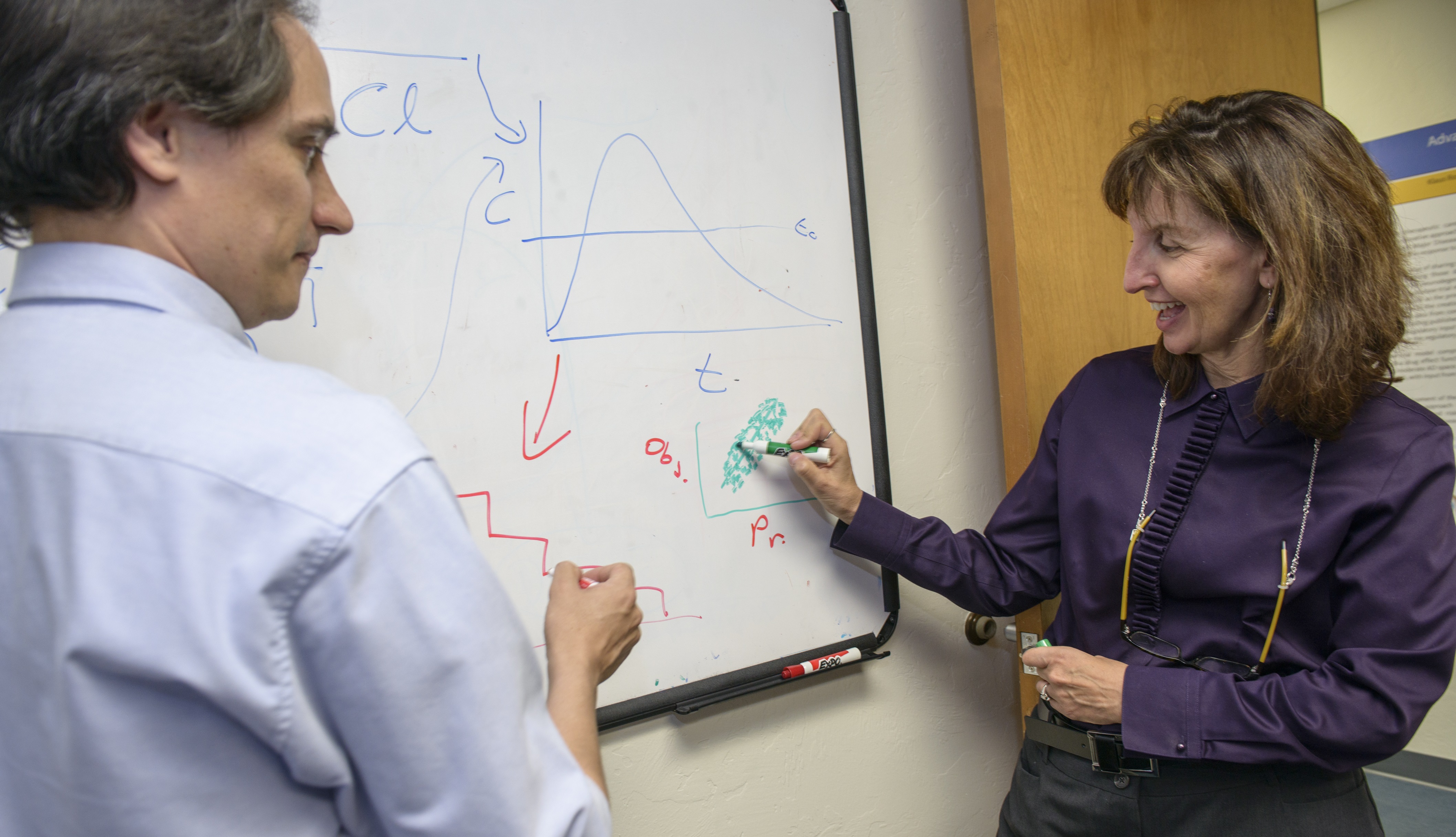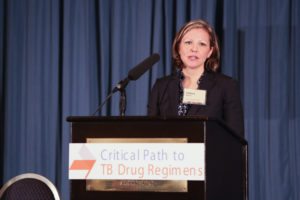
By Brian Powell
Flinn Foundation
The Critical Path Institute may function unbeknownst to the general public and even to members of the medical community, but the trailblazing work it is doing today with diseases such as Alzheimer’s, Parkinson’s, multiple sclerosis and diabetes may have a dramatic impact on the types of conversations physicians and their patients are having in the future.
Martha Brumfield, Ph.D., C-Path’s president and CEO, describes the Tucson-based nonprofit organization’s unique mission as one of advancing novel methodologies and tools through regulatory authorities for the purpose of expediting drug development.
“We all want patients who need medicines to get them as soon as possible and we want those medicines to be as safe as possible,” Brumfield says.
C-Path, which was founded in 2005, works collaboratively with the U.S. Food and Drug Administration, the pharmaceutical industry, and academia to create consensus science. The organization is independent and neutral and has gained respect as a trusted third-party in the work of drug development and the regulatory process for medical products, as well as for large-scale data sharing.

President & CEO
Critical Path Institute
“We are trying to change the paradigm. It’s one little piece at a time,” Brumfield says. “We have seen the same challenges again and again and the same approach again and again and we are not making enough progress. With these tools and methods, we can make better decisions, shorten the timeline and most importantly get effective and safe medicine to patients who need them, specific to their disease.”
A Tucson success
The Critical Path Institute opened its office in Tucson 12 years ago with five employees. The organization was founded by Raymond Woosley, M.D., Ph.D., former vice president of the Arizona Health Sciences Center and dean of the University of Arizona College of Medicine-Tucson, in partnership with the FDA and University of Arizona. Startup funds came from the FDA as well as Science Foundation Arizona and the Phoenix-based Flinn Foundation, a grantmaker that aims to advance the biosciences in Arizona.
Today, C-Path is in the midst of its second five-year grant from the FDA, and draws funding from the pharmaceutical industry on a unique fee-for-participation basis as well as foundations. Its annual budget is about $15 million, double the amount from just three years ago.
The organization operates out of an office complex at the base of Tucson’s Catalina Foothills. C-Path has grown to 73 employees—including five who work remotely. Many are adjunct faculty members at University of Arizona, located about four miles away. There is no research or lab space at C-Path—although the organization does sponsor research elsewhere—but rather traditional office space for the experts in science, drug development, and the regulatory process who are running the organization’s 14 programs.
Brumfield has been the President and CEO of C-Path since February 2013. She began working for the organization as a consultant in 2010 and then served as its director of international and regulatory programs. Brumfield previously spent 20 years with Pfizer Inc., most recently as senior vice president of worldwide regulatory affairs and quality assurance.
While C-Path works virtually with companies, researchers, and agencies from around the world, including the European Medicines Agency and Japan’s Pharmaceuticals and Medical Devices Agency, in the coming years it hopes to establish more face-to-face Arizona connections, like its recently announced partnership with the Phoenix-based Translational Genomics Research Institute to improve the treatment of bacteria-resistant tuberculosis around the globe.
Taking on tuberculosis

Executive Director
Critical Path to TB Drug Regimens Initiative
The Critical Path to TB Drug Regimens, C-Path’s largest program, received a $1.1 million grant in May from the Bill & Melinda Gates Foundation that will enable C-Path and TGen to sequence at least 12,000 tuberculosis bacteria isolates from about 35 countries, including developing nations in Africa, Asia, Eastern Europe, and South America, over the next three years.
The DNA sequencing, which will be done by TGen North in Flagstaff, will help identify drug-resistant patterns. Researchers worldwide will be able to see the results via C-Path’s data-sharing program with the hope it will lead to more precision-medicine treatment options for those suffering from the drug-resistant strain.
Debra Hanna, Ph.D., who joined C-Path in 2011 after spending 11 years in the antibacterial research-and-development unit of Pfizer Global Research and Development, is the executive director of the Critical Path to TB Drug Regimens initiative.
Hanna says there are only about 10,000 cases of tuberculosis in the United States, but one-third of the global population carries the disease and about 2 million people die each year. Yet the standard pharmaceutical option is four decades old, and in most current cases, four drugs must be taken together for up to 24 months to kill the bacteria.
“This is a disease of the developing world and of the poorest of the poor,” Hanna says. “There is very little investment in TB drug development, since there’s little money to be made, so you will see foundations, primarily the Bill & Melinda Gates Foundation, who are now funding companies to innovate in this space: to do the appropriate clinical trials, to get better drugs to patients, and to find ways to make that cost effective so the drugs can get to these parts of the world.”
In Arizona, the drug-resistant varieties of tuberculosis impact Native American populations most significantly, and it is present in neighboring Mexico as well.
“It will take the acquisitions of tens of thousands of more data sets, but when that volume of data is large enough, it’s a clear opportunity for this to drive clinical decision-making,” Hanna says.
Data Collaboration Center
The addition of the TGen sequencing will enhance C-Path’s Data Collaboration Center, a pre-competitive environment which has more than 1,400 scientist and researcher participants from nearly 80 countries.
C-Path integrates and aggregates data—from more than 50,000 subjects to date—so that all data records are organized in the exactly the same way for each disease, whether Alzheimer’s, Parkinson’s, kidney disease, multiple sclerosis, Duchenne muscular dystrophy, or tuberculosis.
Hanna says that when looking for new drug-development tools, or biomarkers, rarely is there enough data in any one institution—whether it’s academia, a pharmaceutical company, or government group—to fully validate a completely novel tool or biomarker.
But now researchers can turn to the data at C-Path, which helps to validate the methodologies to a regulator’s standard.
One example of the benefit of C-Path’s data collection is the development of a clinical-trial simulation tool for mild and moderate Alzheimer’s disease, which was endorsed by the FDA and EMA and applies computerized models to simulate “what-if” scenarios for clinical trials.
“Those are the kind of tools we are trying to validate and get out there for everyone to use so they can make better informed decisions on trial design, which patients they should enroll, and how they are going to measure progression of disease,” Brumfield says.
C-Path programs
The Critical Path Institute’s 14 programs, which include the data-sharing and tuberculosis projects, focus on both adult and pediatric clinical trials and outcomes.
The Pediatric Trials Consortium, for instance, has a mission to create a sustainable infrastructure of trial sites for children. C-Path recently launched a spinoff nonprofit, Institute for Advanced Clinical Trials for Children, to make this a reality.
Brumfield says the goal is to create sites nationally and globally.
“This will provide an opportunity for Arizona physicians to participate, and could be an opportunity for them to be on the cutting-edge of medicine being evaluated in children,” Brumfield says.
And it would provide C-Path another opportunity to work with physicians and researchers right here in Arizona.
For more information about the Critical Path Institute, visit www.c-path.org.
This article first appeared in Arizona Physician—a combined publication of the Arizona Medical Association, Maricopa County Medical Society and Pima County Medical Society—through a collaboration between the Flinn Foundation and the Arizona Medical Association.